Evaluating the Current International Trade Policy in the U.S.
VerifiedAdded on 2023/04/20
|11
|3240
|78
Essay
AI Summary
This essay provides a critical analysis of the current international trade policy in the United States, focusing on the policy's formulation under President Donald Trump and its aim to strengthen the U.S. economy and national security. It discusses the five pillars of the policy: supporting national security, strengthening the U.S. economy, negotiating better trade deals, enforcing trade laws, and reforming the multilateral trading system. The essay highlights shortcomings such as retaliatory actions from targeted nations leading to trade wars and the decline of the U.S. agricultural sector due to imposed tariffs. It also examines the impact of trade agreements like NAFTA and KORUS, and the U.S. trade policy's stance against unfair trade practices by nations like China. The analysis suggests that while the policy aims to protect American interests, it has resulted in negative consequences for certain sectors of the U.S. economy.
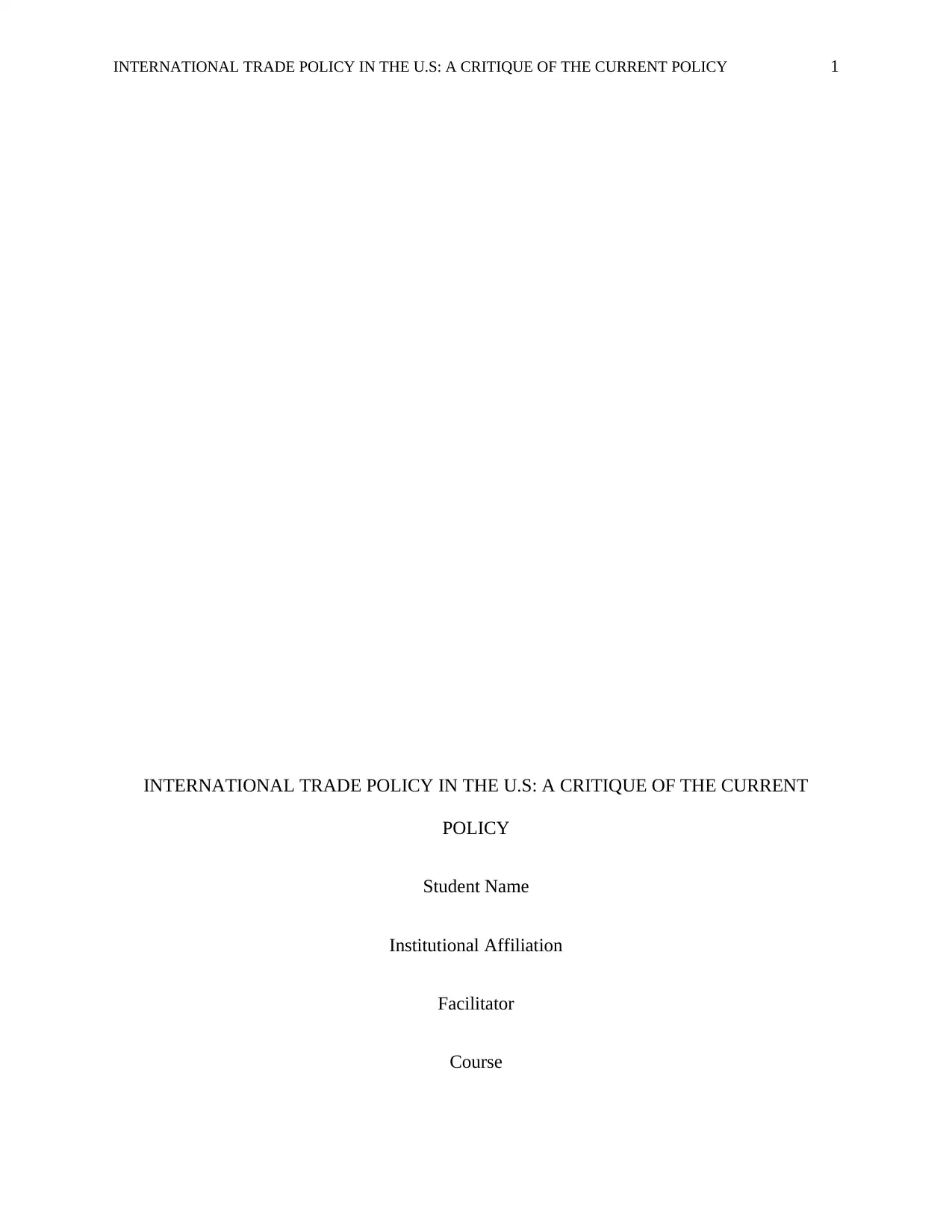
INTERNATIONAL TRADE POLICY IN THE U.S: A CRITIQUE OF THE CURRENT POLICY 1
INTERNATIONAL TRADE POLICY IN THE U.S: A CRITIQUE OF THE CURRENT
POLICY
Student Name
Institutional Affiliation
Facilitator
Course
INTERNATIONAL TRADE POLICY IN THE U.S: A CRITIQUE OF THE CURRENT
POLICY
Student Name
Institutional Affiliation
Facilitator
Course
Paraphrase This Document
Need a fresh take? Get an instant paraphrase of this document with our AI Paraphraser
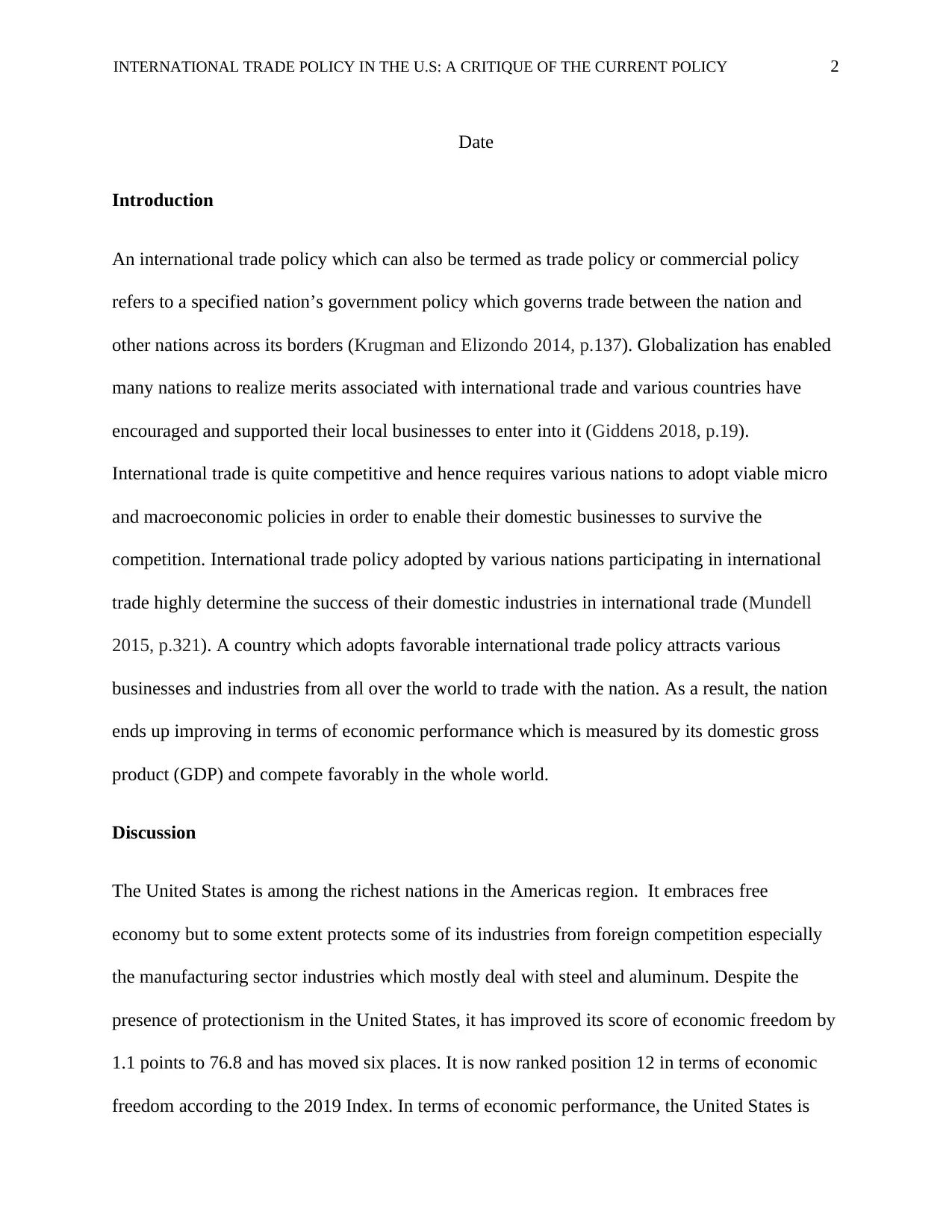
INTERNATIONAL TRADE POLICY IN THE U.S: A CRITIQUE OF THE CURRENT POLICY 2
Date
Introduction
An international trade policy which can also be termed as trade policy or commercial policy
refers to a specified nation’s government policy which governs trade between the nation and
other nations across its borders (Krugman and Elizondo 2014, p.137). Globalization has enabled
many nations to realize merits associated with international trade and various countries have
encouraged and supported their local businesses to enter into it (Giddens 2018, p.19).
International trade is quite competitive and hence requires various nations to adopt viable micro
and macroeconomic policies in order to enable their domestic businesses to survive the
competition. International trade policy adopted by various nations participating in international
trade highly determine the success of their domestic industries in international trade (Mundell
2015, p.321). A country which adopts favorable international trade policy attracts various
businesses and industries from all over the world to trade with the nation. As a result, the nation
ends up improving in terms of economic performance which is measured by its domestic gross
product (GDP) and compete favorably in the whole world.
Discussion
The United States is among the richest nations in the Americas region. It embraces free
economy but to some extent protects some of its industries from foreign competition especially
the manufacturing sector industries which mostly deal with steel and aluminum. Despite the
presence of protectionism in the United States, it has improved its score of economic freedom by
1.1 points to 76.8 and has moved six places. It is now ranked position 12 in terms of economic
freedom according to the 2019 Index. In terms of economic performance, the United States is
Date
Introduction
An international trade policy which can also be termed as trade policy or commercial policy
refers to a specified nation’s government policy which governs trade between the nation and
other nations across its borders (Krugman and Elizondo 2014, p.137). Globalization has enabled
many nations to realize merits associated with international trade and various countries have
encouraged and supported their local businesses to enter into it (Giddens 2018, p.19).
International trade is quite competitive and hence requires various nations to adopt viable micro
and macroeconomic policies in order to enable their domestic businesses to survive the
competition. International trade policy adopted by various nations participating in international
trade highly determine the success of their domestic industries in international trade (Mundell
2015, p.321). A country which adopts favorable international trade policy attracts various
businesses and industries from all over the world to trade with the nation. As a result, the nation
ends up improving in terms of economic performance which is measured by its domestic gross
product (GDP) and compete favorably in the whole world.
Discussion
The United States is among the richest nations in the Americas region. It embraces free
economy but to some extent protects some of its industries from foreign competition especially
the manufacturing sector industries which mostly deal with steel and aluminum. Despite the
presence of protectionism in the United States, it has improved its score of economic freedom by
1.1 points to 76.8 and has moved six places. It is now ranked position 12 in terms of economic
freedom according to the 2019 Index. In terms of economic performance, the United States is
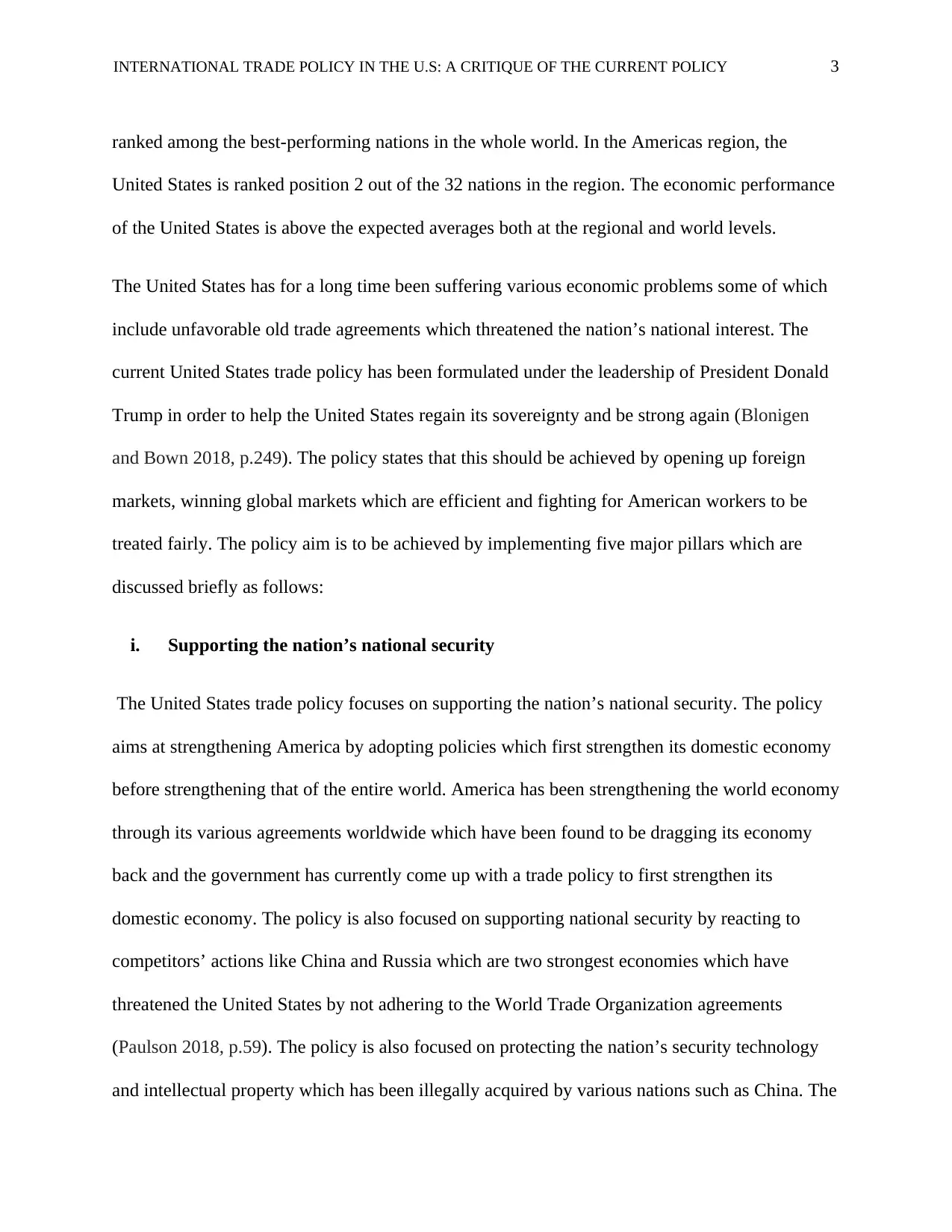
INTERNATIONAL TRADE POLICY IN THE U.S: A CRITIQUE OF THE CURRENT POLICY 3
ranked among the best-performing nations in the whole world. In the Americas region, the
United States is ranked position 2 out of the 32 nations in the region. The economic performance
of the United States is above the expected averages both at the regional and world levels.
The United States has for a long time been suffering various economic problems some of which
include unfavorable old trade agreements which threatened the nation’s national interest. The
current United States trade policy has been formulated under the leadership of President Donald
Trump in order to help the United States regain its sovereignty and be strong again (Blonigen
and Bown 2018, p.249). The policy states that this should be achieved by opening up foreign
markets, winning global markets which are efficient and fighting for American workers to be
treated fairly. The policy aim is to be achieved by implementing five major pillars which are
discussed briefly as follows:
i. Supporting the nation’s national security
The United States trade policy focuses on supporting the nation’s national security. The policy
aims at strengthening America by adopting policies which first strengthen its domestic economy
before strengthening that of the entire world. America has been strengthening the world economy
through its various agreements worldwide which have been found to be dragging its economy
back and the government has currently come up with a trade policy to first strengthen its
domestic economy. The policy is also focused on supporting national security by reacting to
competitors’ actions like China and Russia which are two strongest economies which have
threatened the United States by not adhering to the World Trade Organization agreements
(Paulson 2018, p.59). The policy is also focused on protecting the nation’s security technology
and intellectual property which has been illegally acquired by various nations such as China. The
ranked among the best-performing nations in the whole world. In the Americas region, the
United States is ranked position 2 out of the 32 nations in the region. The economic performance
of the United States is above the expected averages both at the regional and world levels.
The United States has for a long time been suffering various economic problems some of which
include unfavorable old trade agreements which threatened the nation’s national interest. The
current United States trade policy has been formulated under the leadership of President Donald
Trump in order to help the United States regain its sovereignty and be strong again (Blonigen
and Bown 2018, p.249). The policy states that this should be achieved by opening up foreign
markets, winning global markets which are efficient and fighting for American workers to be
treated fairly. The policy aim is to be achieved by implementing five major pillars which are
discussed briefly as follows:
i. Supporting the nation’s national security
The United States trade policy focuses on supporting the nation’s national security. The policy
aims at strengthening America by adopting policies which first strengthen its domestic economy
before strengthening that of the entire world. America has been strengthening the world economy
through its various agreements worldwide which have been found to be dragging its economy
back and the government has currently come up with a trade policy to first strengthen its
domestic economy. The policy is also focused on supporting national security by reacting to
competitors’ actions like China and Russia which are two strongest economies which have
threatened the United States by not adhering to the World Trade Organization agreements
(Paulson 2018, p.59). The policy is also focused on protecting the nation’s security technology
and intellectual property which has been illegally acquired by various nations such as China. The
⊘ This is a preview!⊘
Do you want full access?
Subscribe today to unlock all pages.

Trusted by 1+ million students worldwide
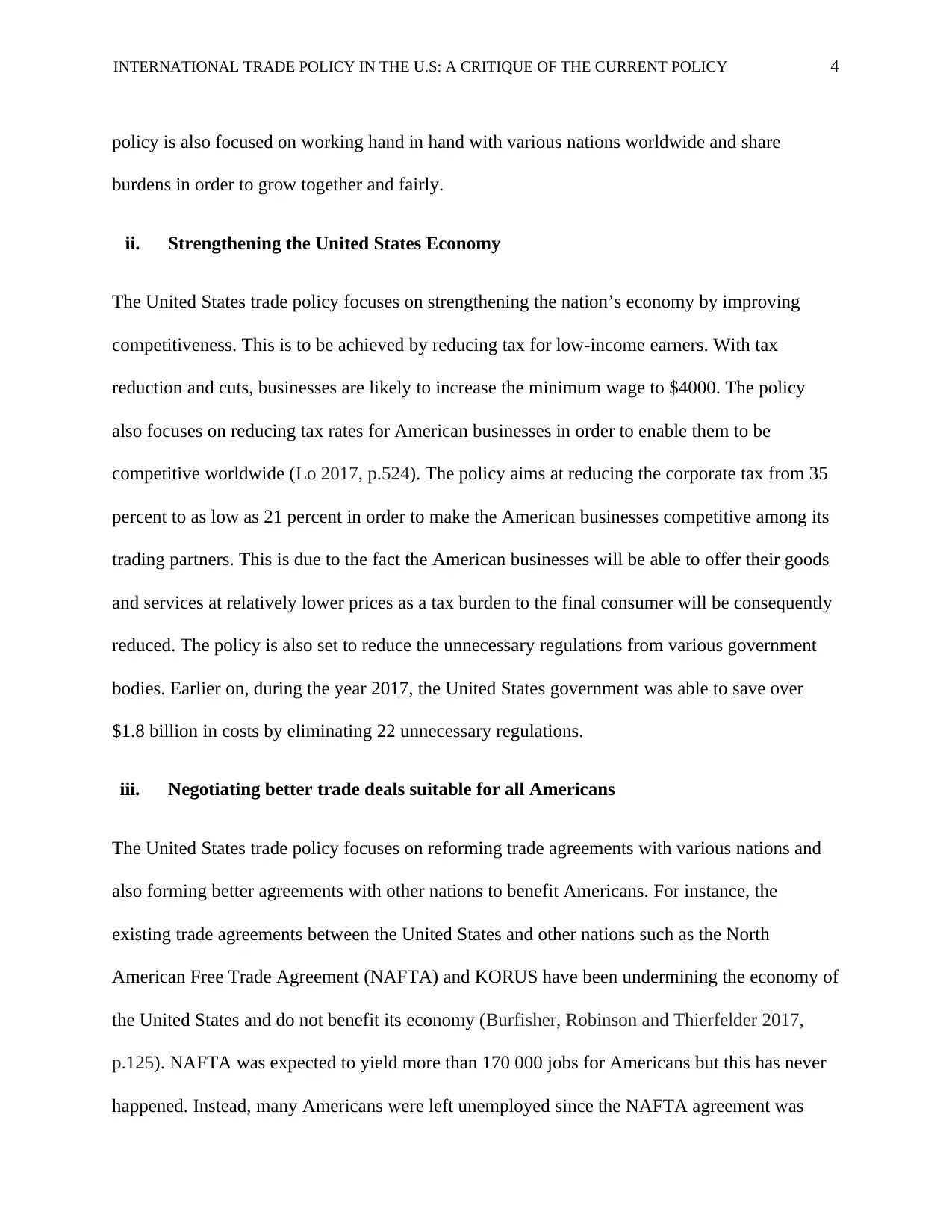
INTERNATIONAL TRADE POLICY IN THE U.S: A CRITIQUE OF THE CURRENT POLICY 4
policy is also focused on working hand in hand with various nations worldwide and share
burdens in order to grow together and fairly.
ii. Strengthening the United States Economy
The United States trade policy focuses on strengthening the nation’s economy by improving
competitiveness. This is to be achieved by reducing tax for low-income earners. With tax
reduction and cuts, businesses are likely to increase the minimum wage to $4000. The policy
also focuses on reducing tax rates for American businesses in order to enable them to be
competitive worldwide (Lo 2017, p.524). The policy aims at reducing the corporate tax from 35
percent to as low as 21 percent in order to make the American businesses competitive among its
trading partners. This is due to the fact the American businesses will be able to offer their goods
and services at relatively lower prices as a tax burden to the final consumer will be consequently
reduced. The policy is also set to reduce the unnecessary regulations from various government
bodies. Earlier on, during the year 2017, the United States government was able to save over
$1.8 billion in costs by eliminating 22 unnecessary regulations.
iii. Negotiating better trade deals suitable for all Americans
The United States trade policy focuses on reforming trade agreements with various nations and
also forming better agreements with other nations to benefit Americans. For instance, the
existing trade agreements between the United States and other nations such as the North
American Free Trade Agreement (NAFTA) and KORUS have been undermining the economy of
the United States and do not benefit its economy (Burfisher, Robinson and Thierfelder 2017,
p.125). NAFTA was expected to yield more than 170 000 jobs for Americans but this has never
happened. Instead, many Americans were left unemployed since the NAFTA agreement was
policy is also focused on working hand in hand with various nations worldwide and share
burdens in order to grow together and fairly.
ii. Strengthening the United States Economy
The United States trade policy focuses on strengthening the nation’s economy by improving
competitiveness. This is to be achieved by reducing tax for low-income earners. With tax
reduction and cuts, businesses are likely to increase the minimum wage to $4000. The policy
also focuses on reducing tax rates for American businesses in order to enable them to be
competitive worldwide (Lo 2017, p.524). The policy aims at reducing the corporate tax from 35
percent to as low as 21 percent in order to make the American businesses competitive among its
trading partners. This is due to the fact the American businesses will be able to offer their goods
and services at relatively lower prices as a tax burden to the final consumer will be consequently
reduced. The policy is also set to reduce the unnecessary regulations from various government
bodies. Earlier on, during the year 2017, the United States government was able to save over
$1.8 billion in costs by eliminating 22 unnecessary regulations.
iii. Negotiating better trade deals suitable for all Americans
The United States trade policy focuses on reforming trade agreements with various nations and
also forming better agreements with other nations to benefit Americans. For instance, the
existing trade agreements between the United States and other nations such as the North
American Free Trade Agreement (NAFTA) and KORUS have been undermining the economy of
the United States and do not benefit its economy (Burfisher, Robinson and Thierfelder 2017,
p.125). NAFTA was expected to yield more than 170 000 jobs for Americans but this has never
happened. Instead, many Americans were left unemployed since the NAFTA agreement was
Paraphrase This Document
Need a fresh take? Get an instant paraphrase of this document with our AI Paraphraser
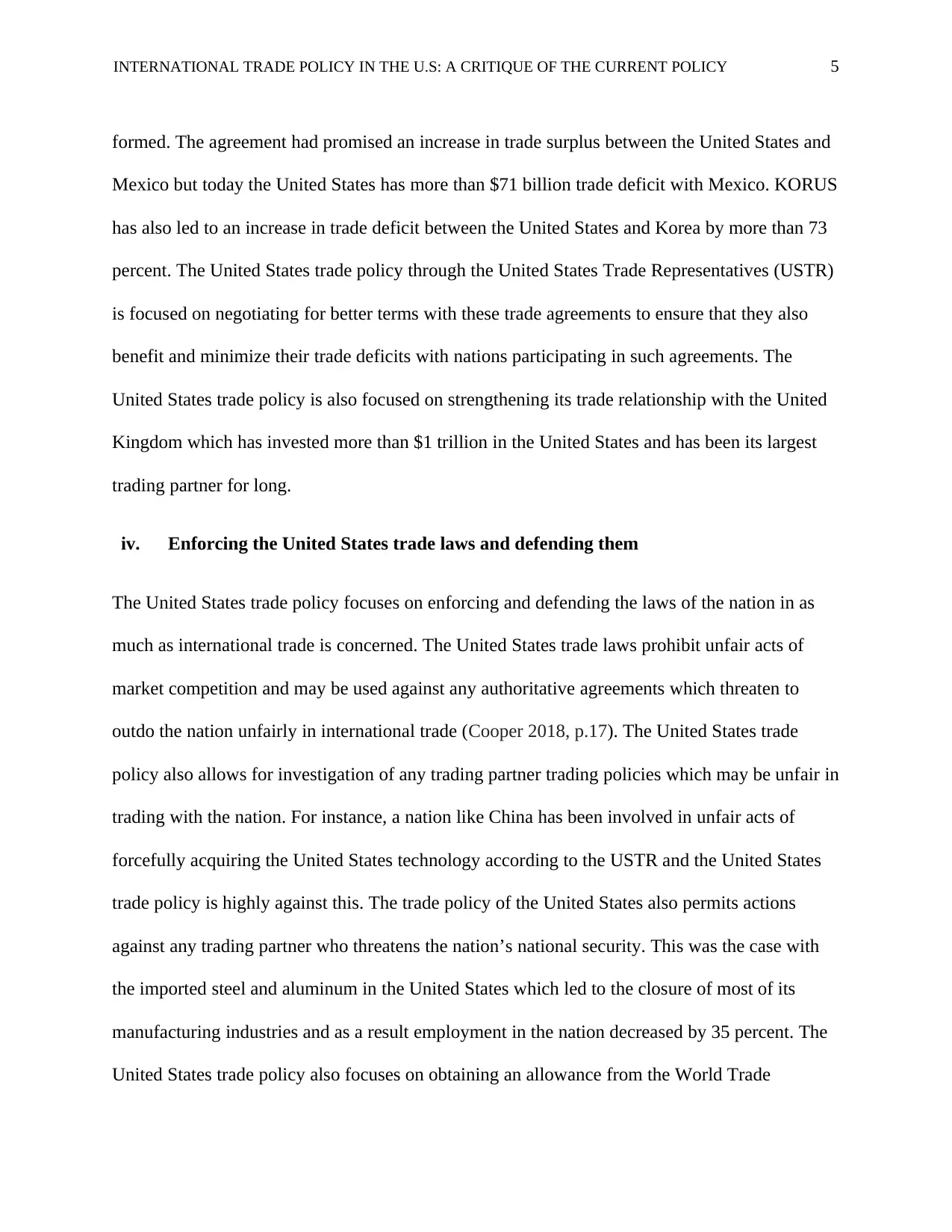
INTERNATIONAL TRADE POLICY IN THE U.S: A CRITIQUE OF THE CURRENT POLICY 5
formed. The agreement had promised an increase in trade surplus between the United States and
Mexico but today the United States has more than $71 billion trade deficit with Mexico. KORUS
has also led to an increase in trade deficit between the United States and Korea by more than 73
percent. The United States trade policy through the United States Trade Representatives (USTR)
is focused on negotiating for better terms with these trade agreements to ensure that they also
benefit and minimize their trade deficits with nations participating in such agreements. The
United States trade policy is also focused on strengthening its trade relationship with the United
Kingdom which has invested more than $1 trillion in the United States and has been its largest
trading partner for long.
iv. Enforcing the United States trade laws and defending them
The United States trade policy focuses on enforcing and defending the laws of the nation in as
much as international trade is concerned. The United States trade laws prohibit unfair acts of
market competition and may be used against any authoritative agreements which threaten to
outdo the nation unfairly in international trade (Cooper 2018, p.17). The United States trade
policy also allows for investigation of any trading partner trading policies which may be unfair in
trading with the nation. For instance, a nation like China has been involved in unfair acts of
forcefully acquiring the United States technology according to the USTR and the United States
trade policy is highly against this. The trade policy of the United States also permits actions
against any trading partner who threatens the nation’s national security. This was the case with
the imported steel and aluminum in the United States which led to the closure of most of its
manufacturing industries and as a result employment in the nation decreased by 35 percent. The
United States trade policy also focuses on obtaining an allowance from the World Trade
formed. The agreement had promised an increase in trade surplus between the United States and
Mexico but today the United States has more than $71 billion trade deficit with Mexico. KORUS
has also led to an increase in trade deficit between the United States and Korea by more than 73
percent. The United States trade policy through the United States Trade Representatives (USTR)
is focused on negotiating for better terms with these trade agreements to ensure that they also
benefit and minimize their trade deficits with nations participating in such agreements. The
United States trade policy is also focused on strengthening its trade relationship with the United
Kingdom which has invested more than $1 trillion in the United States and has been its largest
trading partner for long.
iv. Enforcing the United States trade laws and defending them
The United States trade policy focuses on enforcing and defending the laws of the nation in as
much as international trade is concerned. The United States trade laws prohibit unfair acts of
market competition and may be used against any authoritative agreements which threaten to
outdo the nation unfairly in international trade (Cooper 2018, p.17). The United States trade
policy also allows for investigation of any trading partner trading policies which may be unfair in
trading with the nation. For instance, a nation like China has been involved in unfair acts of
forcefully acquiring the United States technology according to the USTR and the United States
trade policy is highly against this. The trade policy of the United States also permits actions
against any trading partner who threatens the nation’s national security. This was the case with
the imported steel and aluminum in the United States which led to the closure of most of its
manufacturing industries and as a result employment in the nation decreased by 35 percent. The
United States trade policy also focuses on obtaining an allowance from the World Trade
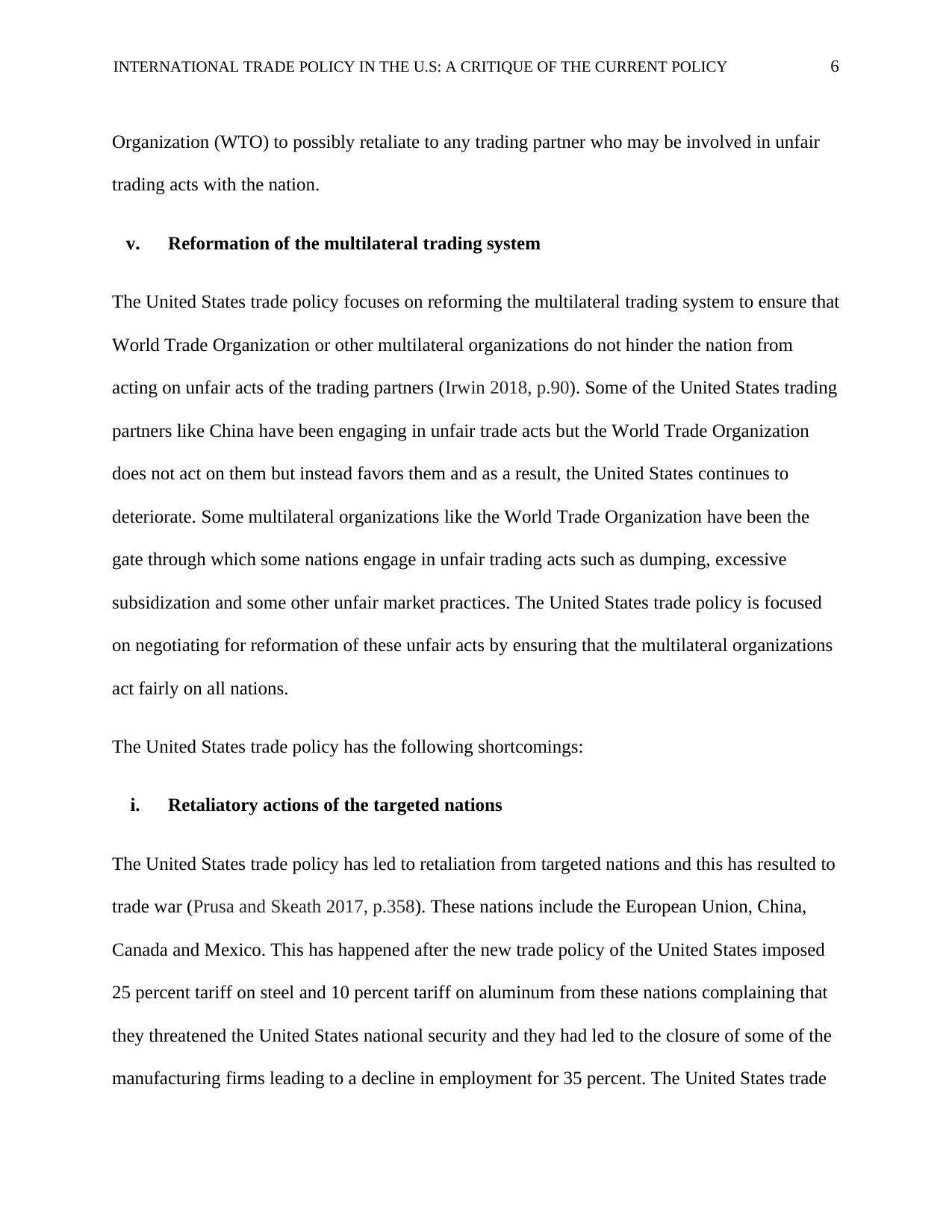
INTERNATIONAL TRADE POLICY IN THE U.S: A CRITIQUE OF THE CURRENT POLICY 6
Organization (WTO) to possibly retaliate to any trading partner who may be involved in unfair
trading acts with the nation.
v. Reformation of the multilateral trading system
The United States trade policy focuses on reforming the multilateral trading system to ensure that
World Trade Organization or other multilateral organizations do not hinder the nation from
acting on unfair acts of the trading partners (Irwin 2018, p.90). Some of the United States trading
partners like China have been engaging in unfair trade acts but the World Trade Organization
does not act on them but instead favors them and as a result, the United States continues to
deteriorate. Some multilateral organizations like the World Trade Organization have been the
gate through which some nations engage in unfair trading acts such as dumping, excessive
subsidization and some other unfair market practices. The United States trade policy is focused
on negotiating for reformation of these unfair acts by ensuring that the multilateral organizations
act fairly on all nations.
The United States trade policy has the following shortcomings:
i. Retaliatory actions of the targeted nations
The United States trade policy has led to retaliation from targeted nations and this has resulted to
trade war (Prusa and Skeath 2017, p.358). These nations include the European Union, China,
Canada and Mexico. This has happened after the new trade policy of the United States imposed
25 percent tariff on steel and 10 percent tariff on aluminum from these nations complaining that
they threatened the United States national security and they had led to the closure of some of the
manufacturing firms leading to a decline in employment for 35 percent. The United States trade
Organization (WTO) to possibly retaliate to any trading partner who may be involved in unfair
trading acts with the nation.
v. Reformation of the multilateral trading system
The United States trade policy focuses on reforming the multilateral trading system to ensure that
World Trade Organization or other multilateral organizations do not hinder the nation from
acting on unfair acts of the trading partners (Irwin 2018, p.90). Some of the United States trading
partners like China have been engaging in unfair trade acts but the World Trade Organization
does not act on them but instead favors them and as a result, the United States continues to
deteriorate. Some multilateral organizations like the World Trade Organization have been the
gate through which some nations engage in unfair trading acts such as dumping, excessive
subsidization and some other unfair market practices. The United States trade policy is focused
on negotiating for reformation of these unfair acts by ensuring that the multilateral organizations
act fairly on all nations.
The United States trade policy has the following shortcomings:
i. Retaliatory actions of the targeted nations
The United States trade policy has led to retaliation from targeted nations and this has resulted to
trade war (Prusa and Skeath 2017, p.358). These nations include the European Union, China,
Canada and Mexico. This has happened after the new trade policy of the United States imposed
25 percent tariff on steel and 10 percent tariff on aluminum from these nations complaining that
they threatened the United States national security and they had led to the closure of some of the
manufacturing firms leading to a decline in employment for 35 percent. The United States trade
⊘ This is a preview!⊘
Do you want full access?
Subscribe today to unlock all pages.

Trusted by 1+ million students worldwide
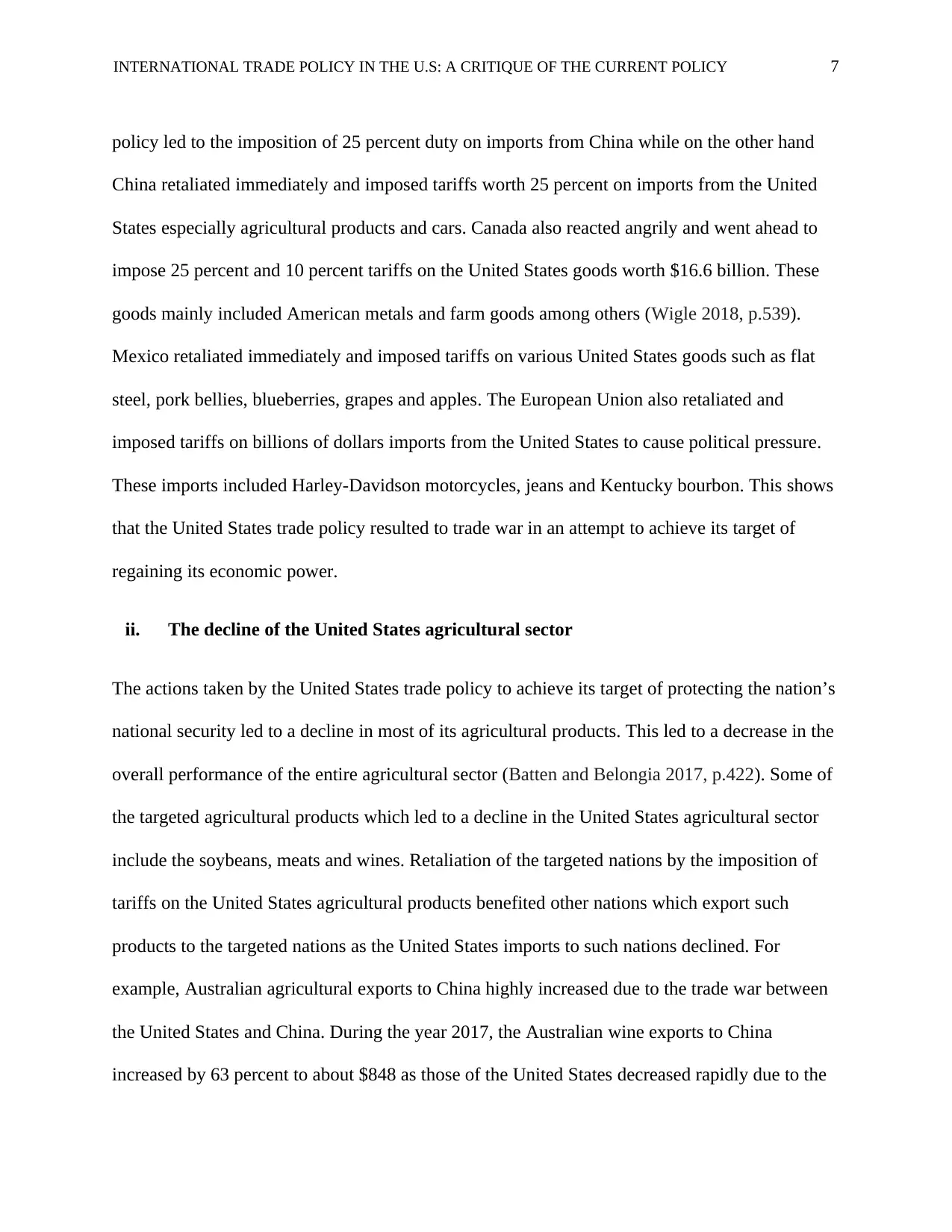
INTERNATIONAL TRADE POLICY IN THE U.S: A CRITIQUE OF THE CURRENT POLICY 7
policy led to the imposition of 25 percent duty on imports from China while on the other hand
China retaliated immediately and imposed tariffs worth 25 percent on imports from the United
States especially agricultural products and cars. Canada also reacted angrily and went ahead to
impose 25 percent and 10 percent tariffs on the United States goods worth $16.6 billion. These
goods mainly included American metals and farm goods among others (Wigle 2018, p.539).
Mexico retaliated immediately and imposed tariffs on various United States goods such as flat
steel, pork bellies, blueberries, grapes and apples. The European Union also retaliated and
imposed tariffs on billions of dollars imports from the United States to cause political pressure.
These imports included Harley-Davidson motorcycles, jeans and Kentucky bourbon. This shows
that the United States trade policy resulted to trade war in an attempt to achieve its target of
regaining its economic power.
ii. The decline of the United States agricultural sector
The actions taken by the United States trade policy to achieve its target of protecting the nation’s
national security led to a decline in most of its agricultural products. This led to a decrease in the
overall performance of the entire agricultural sector (Batten and Belongia 2017, p.422). Some of
the targeted agricultural products which led to a decline in the United States agricultural sector
include the soybeans, meats and wines. Retaliation of the targeted nations by the imposition of
tariffs on the United States agricultural products benefited other nations which export such
products to the targeted nations as the United States imports to such nations declined. For
example, Australian agricultural exports to China highly increased due to the trade war between
the United States and China. During the year 2017, the Australian wine exports to China
increased by 63 percent to about $848 as those of the United States decreased rapidly due to the
policy led to the imposition of 25 percent duty on imports from China while on the other hand
China retaliated immediately and imposed tariffs worth 25 percent on imports from the United
States especially agricultural products and cars. Canada also reacted angrily and went ahead to
impose 25 percent and 10 percent tariffs on the United States goods worth $16.6 billion. These
goods mainly included American metals and farm goods among others (Wigle 2018, p.539).
Mexico retaliated immediately and imposed tariffs on various United States goods such as flat
steel, pork bellies, blueberries, grapes and apples. The European Union also retaliated and
imposed tariffs on billions of dollars imports from the United States to cause political pressure.
These imports included Harley-Davidson motorcycles, jeans and Kentucky bourbon. This shows
that the United States trade policy resulted to trade war in an attempt to achieve its target of
regaining its economic power.
ii. The decline of the United States agricultural sector
The actions taken by the United States trade policy to achieve its target of protecting the nation’s
national security led to a decline in most of its agricultural products. This led to a decrease in the
overall performance of the entire agricultural sector (Batten and Belongia 2017, p.422). Some of
the targeted agricultural products which led to a decline in the United States agricultural sector
include the soybeans, meats and wines. Retaliation of the targeted nations by the imposition of
tariffs on the United States agricultural products benefited other nations which export such
products to the targeted nations as the United States imports to such nations declined. For
example, Australian agricultural exports to China highly increased due to the trade war between
the United States and China. During the year 2017, the Australian wine exports to China
increased by 63 percent to about $848 as those of the United States decreased rapidly due to the
Paraphrase This Document
Need a fresh take? Get an instant paraphrase of this document with our AI Paraphraser
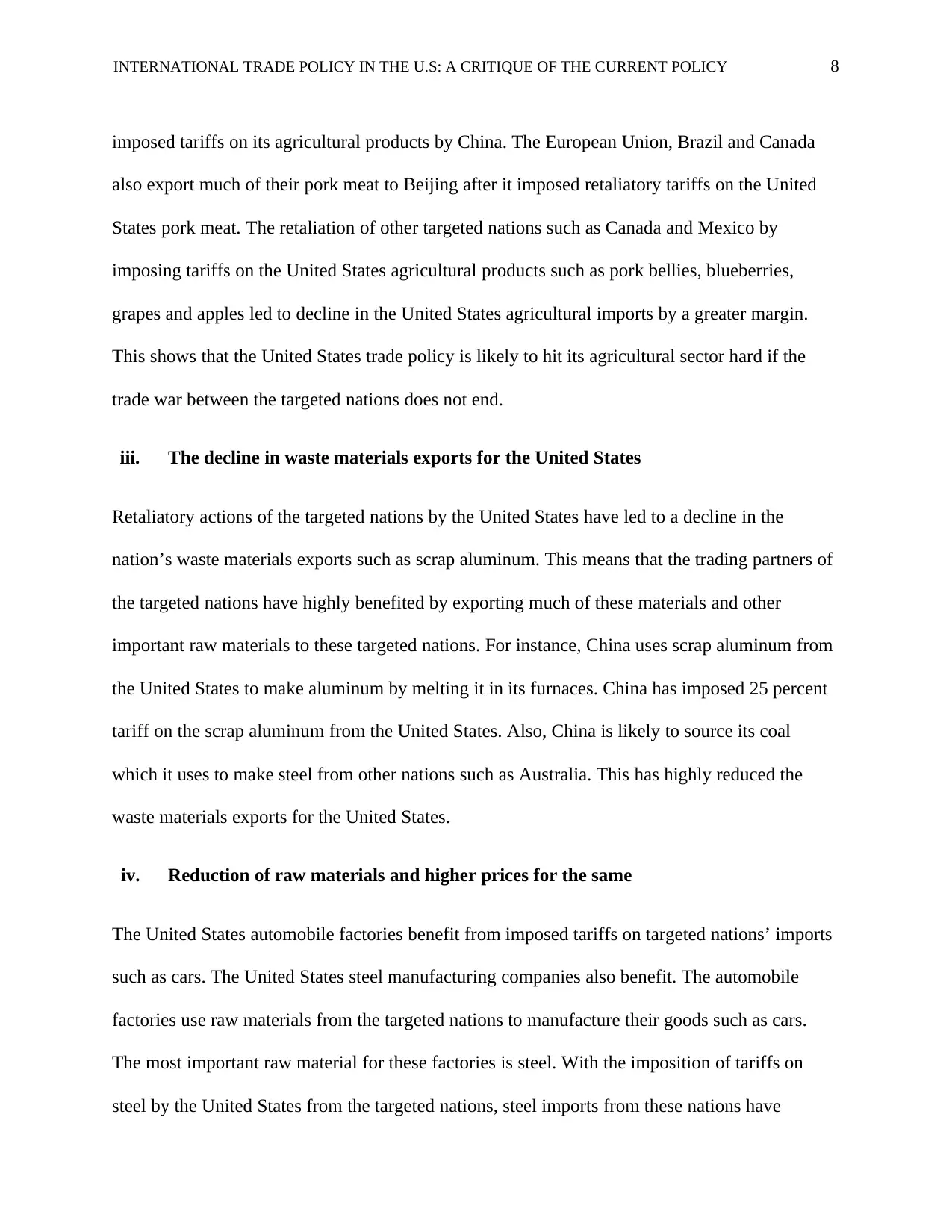
INTERNATIONAL TRADE POLICY IN THE U.S: A CRITIQUE OF THE CURRENT POLICY 8
imposed tariffs on its agricultural products by China. The European Union, Brazil and Canada
also export much of their pork meat to Beijing after it imposed retaliatory tariffs on the United
States pork meat. The retaliation of other targeted nations such as Canada and Mexico by
imposing tariffs on the United States agricultural products such as pork bellies, blueberries,
grapes and apples led to decline in the United States agricultural imports by a greater margin.
This shows that the United States trade policy is likely to hit its agricultural sector hard if the
trade war between the targeted nations does not end.
iii. The decline in waste materials exports for the United States
Retaliatory actions of the targeted nations by the United States have led to a decline in the
nation’s waste materials exports such as scrap aluminum. This means that the trading partners of
the targeted nations have highly benefited by exporting much of these materials and other
important raw materials to these targeted nations. For instance, China uses scrap aluminum from
the United States to make aluminum by melting it in its furnaces. China has imposed 25 percent
tariff on the scrap aluminum from the United States. Also, China is likely to source its coal
which it uses to make steel from other nations such as Australia. This has highly reduced the
waste materials exports for the United States.
iv. Reduction of raw materials and higher prices for the same
The United States automobile factories benefit from imposed tariffs on targeted nations’ imports
such as cars. The United States steel manufacturing companies also benefit. The automobile
factories use raw materials from the targeted nations to manufacture their goods such as cars.
The most important raw material for these factories is steel. With the imposition of tariffs on
steel by the United States from the targeted nations, steel imports from these nations have
imposed tariffs on its agricultural products by China. The European Union, Brazil and Canada
also export much of their pork meat to Beijing after it imposed retaliatory tariffs on the United
States pork meat. The retaliation of other targeted nations such as Canada and Mexico by
imposing tariffs on the United States agricultural products such as pork bellies, blueberries,
grapes and apples led to decline in the United States agricultural imports by a greater margin.
This shows that the United States trade policy is likely to hit its agricultural sector hard if the
trade war between the targeted nations does not end.
iii. The decline in waste materials exports for the United States
Retaliatory actions of the targeted nations by the United States have led to a decline in the
nation’s waste materials exports such as scrap aluminum. This means that the trading partners of
the targeted nations have highly benefited by exporting much of these materials and other
important raw materials to these targeted nations. For instance, China uses scrap aluminum from
the United States to make aluminum by melting it in its furnaces. China has imposed 25 percent
tariff on the scrap aluminum from the United States. Also, China is likely to source its coal
which it uses to make steel from other nations such as Australia. This has highly reduced the
waste materials exports for the United States.
iv. Reduction of raw materials and higher prices for the same
The United States automobile factories benefit from imposed tariffs on targeted nations’ imports
such as cars. The United States steel manufacturing companies also benefit. The automobile
factories use raw materials from the targeted nations to manufacture their goods such as cars.
The most important raw material for these factories is steel. With the imposition of tariffs on
steel by the United States from the targeted nations, steel imports from these nations have
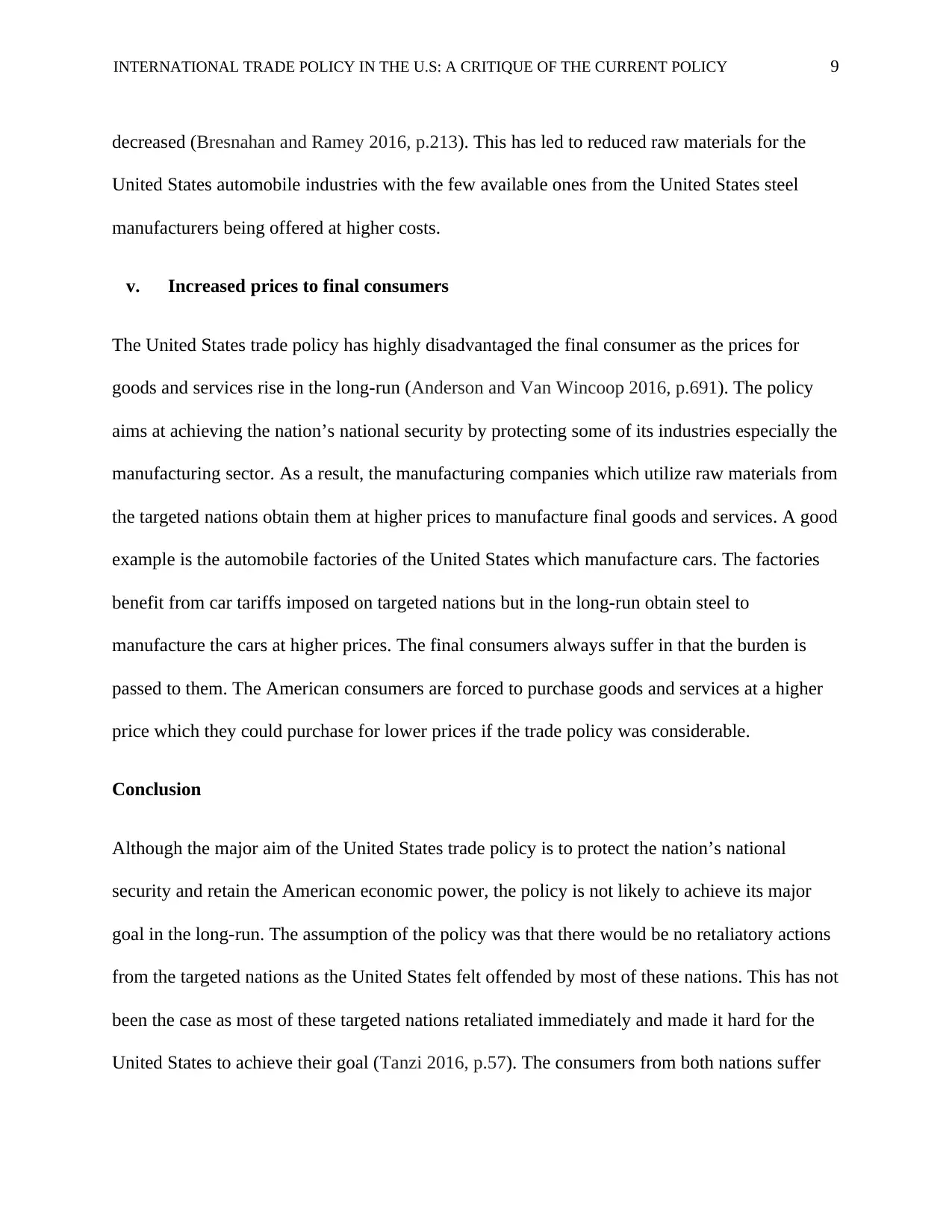
INTERNATIONAL TRADE POLICY IN THE U.S: A CRITIQUE OF THE CURRENT POLICY 9
decreased (Bresnahan and Ramey 2016, p.213). This has led to reduced raw materials for the
United States automobile industries with the few available ones from the United States steel
manufacturers being offered at higher costs.
v. Increased prices to final consumers
The United States trade policy has highly disadvantaged the final consumer as the prices for
goods and services rise in the long-run (Anderson and Van Wincoop 2016, p.691). The policy
aims at achieving the nation’s national security by protecting some of its industries especially the
manufacturing sector. As a result, the manufacturing companies which utilize raw materials from
the targeted nations obtain them at higher prices to manufacture final goods and services. A good
example is the automobile factories of the United States which manufacture cars. The factories
benefit from car tariffs imposed on targeted nations but in the long-run obtain steel to
manufacture the cars at higher prices. The final consumers always suffer in that the burden is
passed to them. The American consumers are forced to purchase goods and services at a higher
price which they could purchase for lower prices if the trade policy was considerable.
Conclusion
Although the major aim of the United States trade policy is to protect the nation’s national
security and retain the American economic power, the policy is not likely to achieve its major
goal in the long-run. The assumption of the policy was that there would be no retaliatory actions
from the targeted nations as the United States felt offended by most of these nations. This has not
been the case as most of these targeted nations retaliated immediately and made it hard for the
United States to achieve their goal (Tanzi 2016, p.57). The consumers from both nations suffer
decreased (Bresnahan and Ramey 2016, p.213). This has led to reduced raw materials for the
United States automobile industries with the few available ones from the United States steel
manufacturers being offered at higher costs.
v. Increased prices to final consumers
The United States trade policy has highly disadvantaged the final consumer as the prices for
goods and services rise in the long-run (Anderson and Van Wincoop 2016, p.691). The policy
aims at achieving the nation’s national security by protecting some of its industries especially the
manufacturing sector. As a result, the manufacturing companies which utilize raw materials from
the targeted nations obtain them at higher prices to manufacture final goods and services. A good
example is the automobile factories of the United States which manufacture cars. The factories
benefit from car tariffs imposed on targeted nations but in the long-run obtain steel to
manufacture the cars at higher prices. The final consumers always suffer in that the burden is
passed to them. The American consumers are forced to purchase goods and services at a higher
price which they could purchase for lower prices if the trade policy was considerable.
Conclusion
Although the major aim of the United States trade policy is to protect the nation’s national
security and retain the American economic power, the policy is not likely to achieve its major
goal in the long-run. The assumption of the policy was that there would be no retaliatory actions
from the targeted nations as the United States felt offended by most of these nations. This has not
been the case as most of these targeted nations retaliated immediately and made it hard for the
United States to achieve their goal (Tanzi 2016, p.57). The consumers from both nations suffer
⊘ This is a preview!⊘
Do you want full access?
Subscribe today to unlock all pages.

Trusted by 1+ million students worldwide
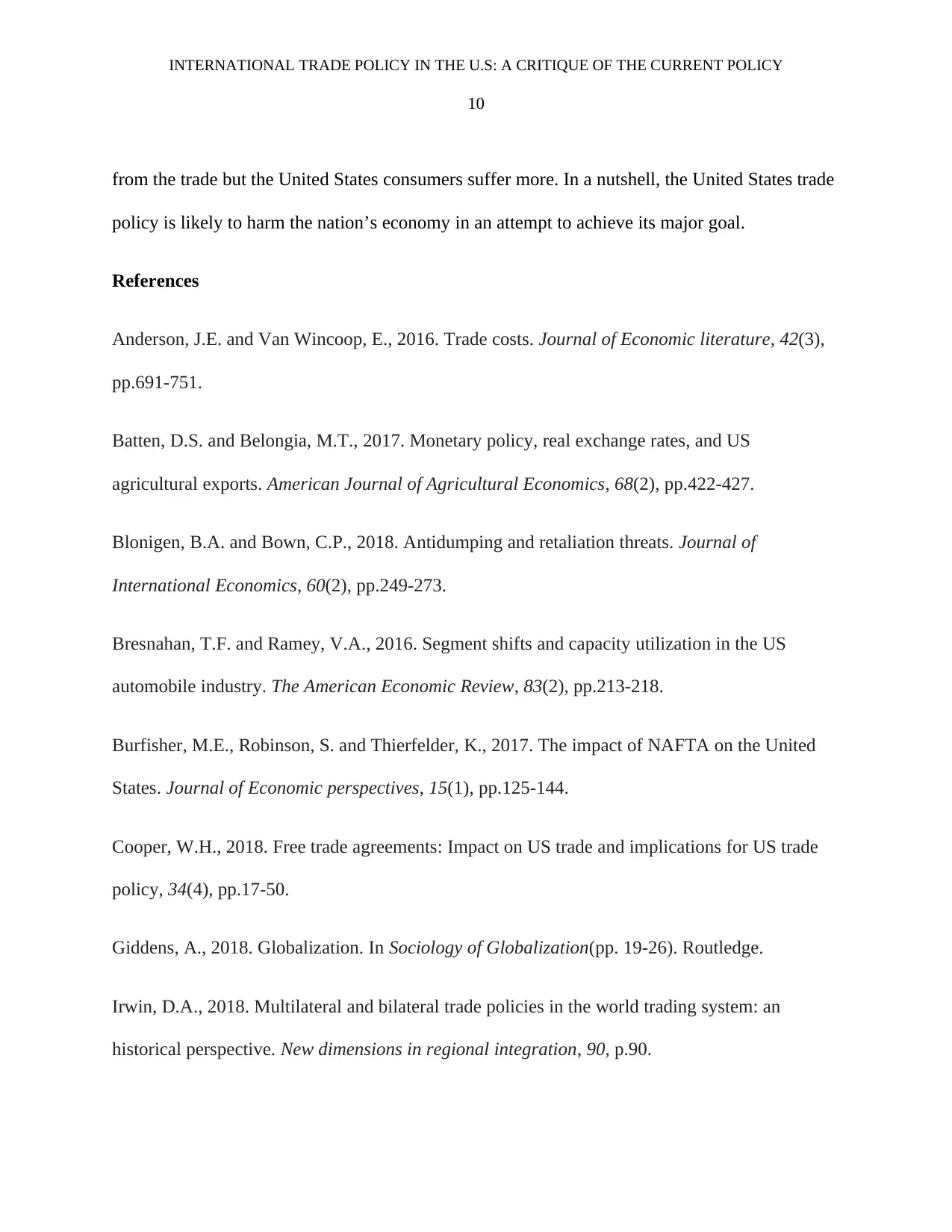
INTERNATIONAL TRADE POLICY IN THE U.S: A CRITIQUE OF THE CURRENT POLICY
10
from the trade but the United States consumers suffer more. In a nutshell, the United States trade
policy is likely to harm the nation’s economy in an attempt to achieve its major goal.
References
Anderson, J.E. and Van Wincoop, E., 2016. Trade costs. Journal of Economic literature, 42(3),
pp.691-751.
Batten, D.S. and Belongia, M.T., 2017. Monetary policy, real exchange rates, and US
agricultural exports. American Journal of Agricultural Economics, 68(2), pp.422-427.
Blonigen, B.A. and Bown, C.P., 2018. Antidumping and retaliation threats. Journal of
International Economics, 60(2), pp.249-273.
Bresnahan, T.F. and Ramey, V.A., 2016. Segment shifts and capacity utilization in the US
automobile industry. The American Economic Review, 83(2), pp.213-218.
Burfisher, M.E., Robinson, S. and Thierfelder, K., 2017. The impact of NAFTA on the United
States. Journal of Economic perspectives, 15(1), pp.125-144.
Cooper, W.H., 2018. Free trade agreements: Impact on US trade and implications for US trade
policy, 34(4), pp.17-50.
Giddens, A., 2018. Globalization. In Sociology of Globalization(pp. 19-26). Routledge.
Irwin, D.A., 2018. Multilateral and bilateral trade policies in the world trading system: an
historical perspective. New dimensions in regional integration, 90, p.90.
10
from the trade but the United States consumers suffer more. In a nutshell, the United States trade
policy is likely to harm the nation’s economy in an attempt to achieve its major goal.
References
Anderson, J.E. and Van Wincoop, E., 2016. Trade costs. Journal of Economic literature, 42(3),
pp.691-751.
Batten, D.S. and Belongia, M.T., 2017. Monetary policy, real exchange rates, and US
agricultural exports. American Journal of Agricultural Economics, 68(2), pp.422-427.
Blonigen, B.A. and Bown, C.P., 2018. Antidumping and retaliation threats. Journal of
International Economics, 60(2), pp.249-273.
Bresnahan, T.F. and Ramey, V.A., 2016. Segment shifts and capacity utilization in the US
automobile industry. The American Economic Review, 83(2), pp.213-218.
Burfisher, M.E., Robinson, S. and Thierfelder, K., 2017. The impact of NAFTA on the United
States. Journal of Economic perspectives, 15(1), pp.125-144.
Cooper, W.H., 2018. Free trade agreements: Impact on US trade and implications for US trade
policy, 34(4), pp.17-50.
Giddens, A., 2018. Globalization. In Sociology of Globalization(pp. 19-26). Routledge.
Irwin, D.A., 2018. Multilateral and bilateral trade policies in the world trading system: an
historical perspective. New dimensions in regional integration, 90, p.90.
Paraphrase This Document
Need a fresh take? Get an instant paraphrase of this document with our AI Paraphraser
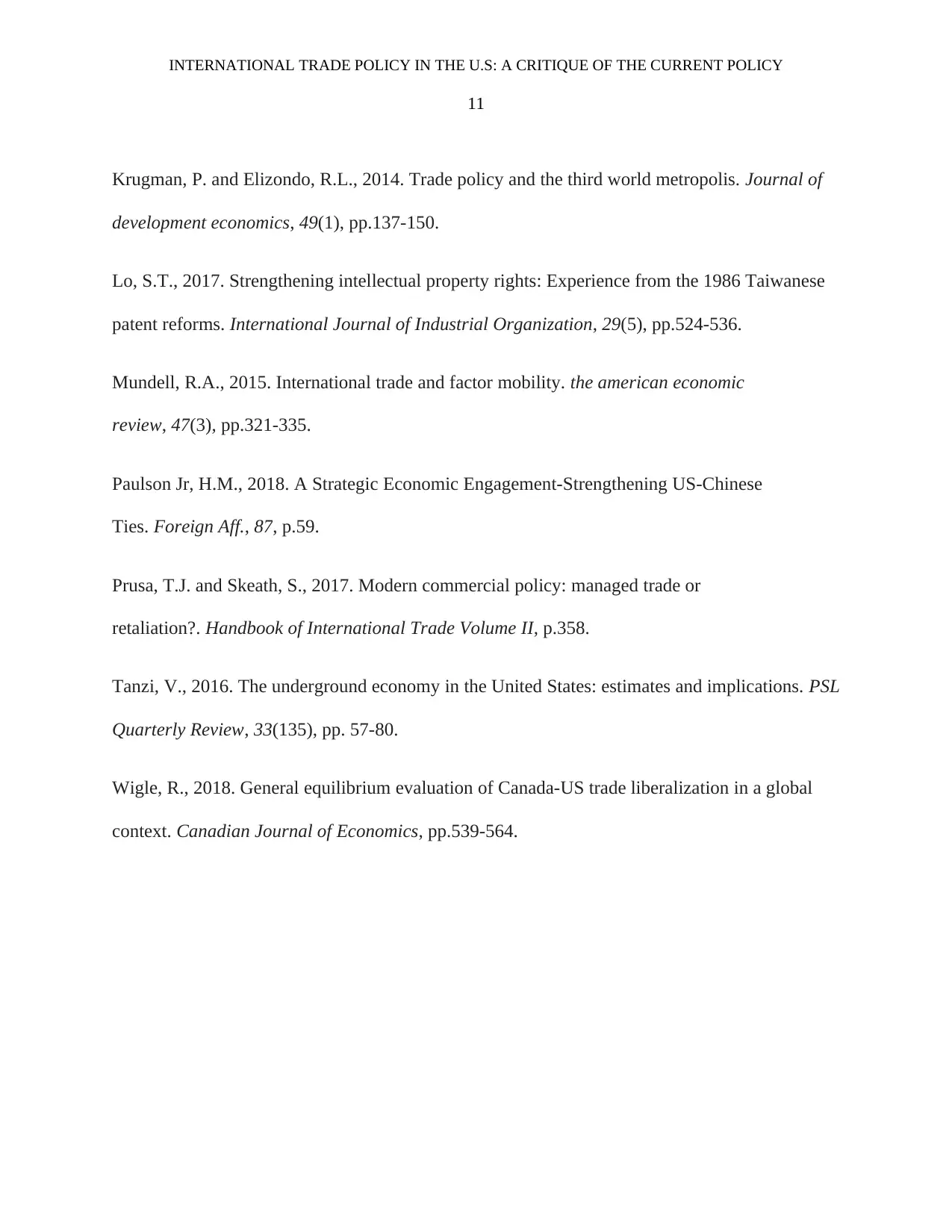
INTERNATIONAL TRADE POLICY IN THE U.S: A CRITIQUE OF THE CURRENT POLICY
11
Krugman, P. and Elizondo, R.L., 2014. Trade policy and the third world metropolis. Journal of
development economics, 49(1), pp.137-150.
Lo, S.T., 2017. Strengthening intellectual property rights: Experience from the 1986 Taiwanese
patent reforms. International Journal of Industrial Organization, 29(5), pp.524-536.
Mundell, R.A., 2015. International trade and factor mobility. the american economic
review, 47(3), pp.321-335.
Paulson Jr, H.M., 2018. A Strategic Economic Engagement-Strengthening US-Chinese
Ties. Foreign Aff., 87, p.59.
Prusa, T.J. and Skeath, S., 2017. Modern commercial policy: managed trade or
retaliation?. Handbook of International Trade Volume II, p.358.
Tanzi, V., 2016. The underground economy in the United States: estimates and implications. PSL
Quarterly Review, 33(135), pp. 57-80.
Wigle, R., 2018. General equilibrium evaluation of Canada-US trade liberalization in a global
context. Canadian Journal of Economics, pp.539-564.
11
Krugman, P. and Elizondo, R.L., 2014. Trade policy and the third world metropolis. Journal of
development economics, 49(1), pp.137-150.
Lo, S.T., 2017. Strengthening intellectual property rights: Experience from the 1986 Taiwanese
patent reforms. International Journal of Industrial Organization, 29(5), pp.524-536.
Mundell, R.A., 2015. International trade and factor mobility. the american economic
review, 47(3), pp.321-335.
Paulson Jr, H.M., 2018. A Strategic Economic Engagement-Strengthening US-Chinese
Ties. Foreign Aff., 87, p.59.
Prusa, T.J. and Skeath, S., 2017. Modern commercial policy: managed trade or
retaliation?. Handbook of International Trade Volume II, p.358.
Tanzi, V., 2016. The underground economy in the United States: estimates and implications. PSL
Quarterly Review, 33(135), pp. 57-80.
Wigle, R., 2018. General equilibrium evaluation of Canada-US trade liberalization in a global
context. Canadian Journal of Economics, pp.539-564.
1 out of 11
Related Documents
Your All-in-One AI-Powered Toolkit for Academic Success.
+13062052269
info@desklib.com
Available 24*7 on WhatsApp / Email
![[object Object]](/_next/static/media/star-bottom.7253800d.svg)
Unlock your academic potential
Copyright © 2020–2025 A2Z Services. All Rights Reserved. Developed and managed by ZUCOL.





